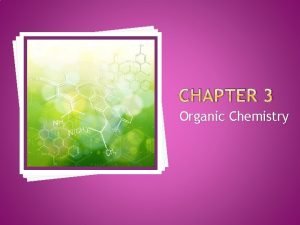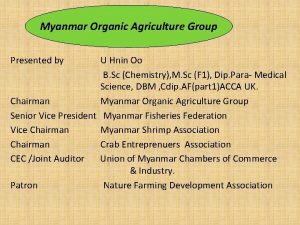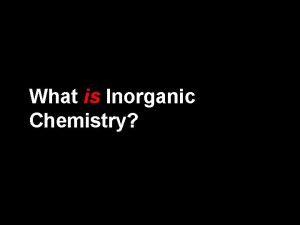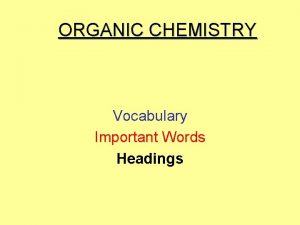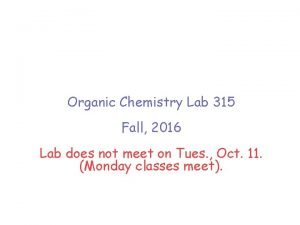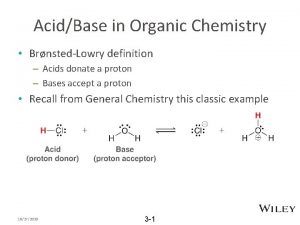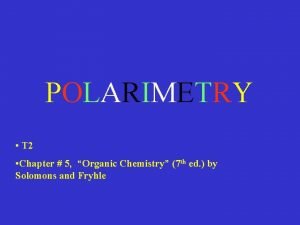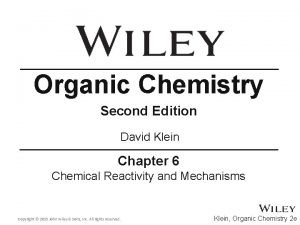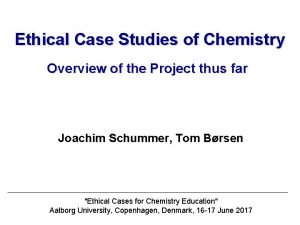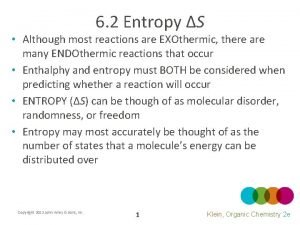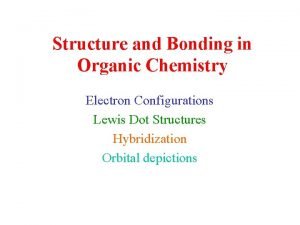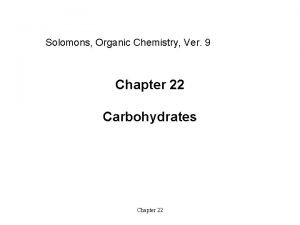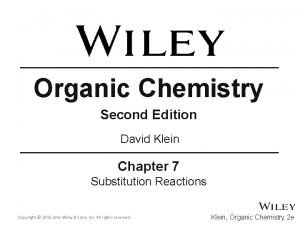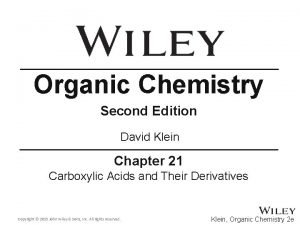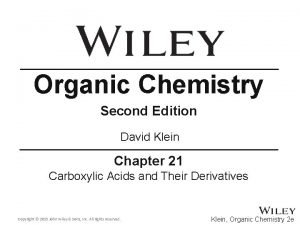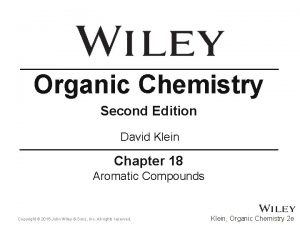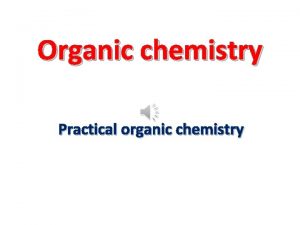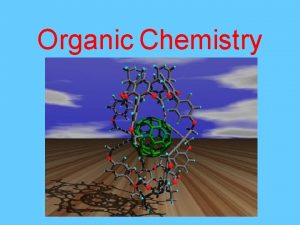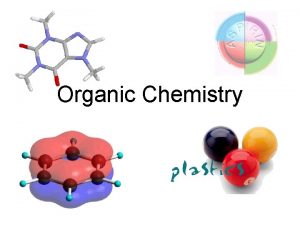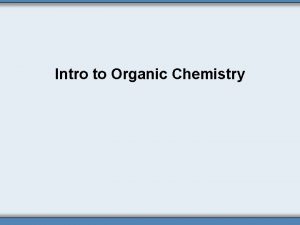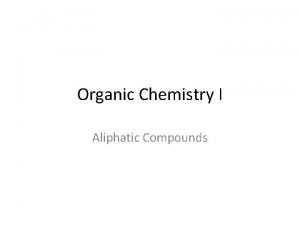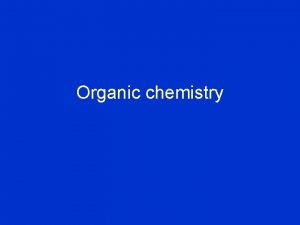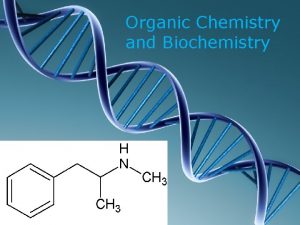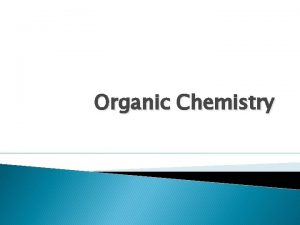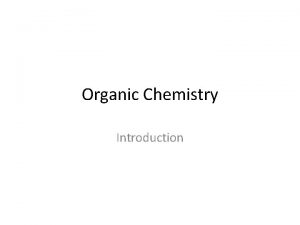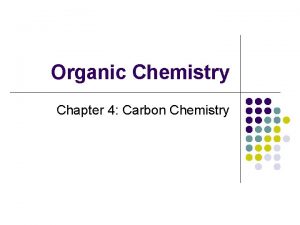Organic Chemistry 6 th Edition Chapter 9 Paula



























































- Slides: 59

Organic Chemistry 6 th Edition Chapter 9 Paula Yurkanis Bruice Elimination Reactions of Alkyl Halides Competition Between Substitution and Elimination 1 © 2011 Pearson Education, Inc.

In addition to substitution, an alkyl halide can undergo an elimination reaction 2 © 2011 Pearson Education, Inc.

The E 2 Reaction Hydroxide cannot act as a nucleophile in this reaction because of the bulky tertiary halide. Rather, hydroxide acts as a base and abstracts a proton. 3 © 2011 Pearson Education, Inc.

The removal of a proton and a halide ion is called dehydrohalogenation: 4 © 2011 Pearson Education, Inc.

An E 2 reaction is also called a b-elimination or a 1, 2 -elimination reaction: The weaker the base, the better it is as a leaving group 5 © 2011 Pearson Education, Inc.

The Regioselectivity of the E 2 Reaction The major product of an E 2 reaction is the most stable alkene: 6 © 2011 Pearson Education, Inc.

Reaction coordinate diagram for the E 2 reaction of 2 -bromobutane and methoxide ion 7 © 2011 Pearson Education, Inc.

8 © 2011 Pearson Education, Inc.

The Zaitsev Rule The more substituted alkene product is obtained when a proton is removed from the b-carbon that is bonded to the fewest hydrogens The most stable alkene is generally (but not always) the most substituted alkene 9 © 2011 Pearson Education, Inc.

10 © 2011 Pearson Education, Inc.

Conjugated alkene products are preferred over the more substituted alkene product: Do not use Zaitsev’s rule to predict the major product in these cases 11 © 2011 Pearson Education, Inc.

Bulky bases affect the product distribution resulting in the Hofmann product, the least substituted alkene: Hofmann product Zaitsev product However, it takes a lot of steric hindrance for the less stable product to be the major product: 12 © 2011 Pearson Education, Inc.

13 © 2011 Pearson Education, Inc.

Another exception to Zaitsev’s rule 14 © 2011 Pearson Education, Inc.

Consider the elimination of 2 -fluoropentane… A carbanion-like transition state 15 © 2011 Pearson Education, Inc.

Therefore, the major product of an E 2 elimination reaction is the more stable alkene except if the reactants are sterically hindered or the leaving group is poor 16 © 2011 Pearson Education, Inc.

The E 1 Reaction A unimolecular reaction: 17 © 2011 Pearson Education, Inc.

The E 1 reaction, like the SN 1 reaction, involves a carbocation intermediate: 18 © 2011 Pearson Education, Inc.

How does a weak base like water remove a proton from an sp 3 carbon? 1) The presence of a positive charge greatly reduces the p. Ka 2) Hyperconjugation weakens the C-H bond by electron density 19 © 2011 Pearson Education, Inc.

The major product in an E 1 reaction is generally the more substituted alkene 20 © 2011 Pearson Education, Inc.

Reaction coordinate diagram for the E 1 reaction of 2 -chloro-2 -methylbutane 21 © 2011 Pearson Education, Inc.

Because the first step is the rate-determining step, the rate of an E 1 reaction depends both on the ease with which the carbocation is formed and how readily the leaving group leaves 22 © 2011 Pearson Education, Inc.

Because the E 1 reaction forms a carbocation intermediate, we need to consider carbocation rearrangement 23 © 2011 Pearson Education, Inc.

Competition Between E 2 and E 1 Reactions An E 2 is favored by a high concentration of strong base and an aprotic polar solvent An E 1 is favored by a weak base and a protic polar solvent Review Section 8. 10 24 © 2011 Pearson Education, Inc.

Stereochemistry of the E 2 Reaction The bonds to the eliminated groups (H and X) must be in the same plane The anti elimination is favored over the syn elimination 25 © 2011 Pearson Education, Inc.

Another view of the E 2 reaction mechanism The best overlap of the interacting orbitals is achieved through back-side attack Anti elimination avoids repulsion of the electron-rich base © 2011 Pearson Education, Inc. 26

Consider the stereoselectivity of the E 2 reaction The alkene with the bulkiest groups on opposite sides of the double bond will be formed in greater yield, because it is the more stable alkene 27 © 2011 Pearson Education, Inc.

28 © 2011 Pearson Education, Inc.

Reaction coordinate diagram for the E 2 reaction of 2 -bromopentane and ethoxide ion 29 © 2011 Pearson Education, Inc.

30 © 2011 Pearson Education, Inc.

When only one hydrogen is bonded to the b-carbon, the major product of an E 2 reaction depends on the structure of the alkene 31 © 2011 Pearson Education, Inc.

Stereochemistry of the E 1 Reaction The major stereoisomer obtained from an E 1 reaction is the alkene in which the bulkiest substituents are on opposite sides of the double bond Both syn and anti elimination can occur in an E 1 reaction 32 © 2011 Pearson Education, Inc.

Elimination from Cyclic Compounds In an E 2 reaction, groups to be eliminated must be in axial positions 33 © 2011 Pearson Education, Inc.

34 © 2011 Pearson Education, Inc.

35 © 2011 Pearson Education, Inc.

36 © 2011 Pearson Education, Inc.

37 © 2011 Pearson Education, Inc.

The hydrogen that is removed and the leaving group both have to be in the axial position, therefore… 38 © 2011 Pearson Education, Inc.

E 1 Elimination from Cyclic Compounds No axial orientation required for the E 1 reaction. 39 © 2011 Pearson Education, Inc.

40 © 2011 Pearson Education, Inc.

41 © 2011 Pearson Education, Inc.

Utilization of kinetic isotope effect to study a reaction mechanism A carbon deuterium bond (C–D) is stronger than a carbon hydrogen bond (C–H) The deuterium kinetic isotope effect is 7. 1, indicating that a C–H (or C–D) bond must be broken in the rate-determining step 42 © 2011 Pearson Education, Inc.

Competition Between Substitution and Elimination Alkyl halides can undergo SN 2, SN 1, E 2, and E 1 1) decide whether the reaction conditions favor SN 2/E 2 or SN 1/E 1 • SN 2/E 2 reactions are favored by a high concentration of a good nucleophile/strong base • SN 1/E 1 reactions are favored by a poor nucleophile/weak base 2) decide how much of the product will be the substitution product and how much of the product will be the elimination product 43 © 2011 Pearson Education, Inc.

Consider the SN 2/E 2 conditions 44 © 2011 Pearson Education, Inc.

A bulky alkyl halide or a sterically hindered nucleophile encourages elimination over substitution 45 © 2011 Pearson Education, Inc.

A strong or a bulky base encourages elimination over substitution 46 © 2011 Pearson Education, Inc.

High temperature favors elimination over substitution: Why? Because elimination is entropically favorable. 47 © 2011 Pearson Education, Inc.

Tertiary alkyl halides undergo only elimination under SN 2/E 2 conditions: 48 © 2011 Pearson Education, Inc.

Consider SN 1/E 1 conditions: The elimination reaction favored at higher temperatures. Primary alkyl halides do not form carbocations; therefore they cannot undergo SN 1 and E 1 reactions. 49 © 2011 Pearson Education, Inc.

50 © 2011 Pearson Education, Inc.

Substitution and Elimination Reactions in Synthesis 51 © 2011 Pearson Education, Inc.

In synthesizing an ether, the less hindered group should be provided by the alkyl halide 52 © 2011 Pearson Education, Inc.

However, the most hindered alkyl halide should be used if you want to synthesize an alkene 53 © 2011 Pearson Education, Inc.

The E 2 reaction should be used if you want to synthesize an alkene: Hydroxide Water 54 © 2011 Pearson Education, Inc.

Consecutive E 2 Elimination Reactions Requires a strong base Na. NH 2. Reaction carried out in liquid ammonia. 55 © 2011 Pearson Education, Inc.

Synthesis Example 56 © 2011 Pearson Education, Inc.

Synthesis Example Racemic 57 © 2011 Pearson Education, Inc.

Synthesis Example 58 © 2011 Pearson Education, Inc.

Synthesis Example 59 © 2011 Pearson Education, Inc.
 Thermodynamic vs kinetic control
Thermodynamic vs kinetic control Acid chloride + grignard reagent
Acid chloride + grignard reagent Halohydrin
Halohydrin Organic chemistry david klein 3rd edition
Organic chemistry david klein 3rd edition Organic chemistry 2nd edition klein
Organic chemistry 2nd edition klein David klein organic chemistry 3rd edition
David klein organic chemistry 3rd edition Organic chemistry third edition david klein
Organic chemistry third edition david klein Thermodynamic control
Thermodynamic control Organic chemistry
Organic chemistry Ib organic chemistry functional groups
Ib organic chemistry functional groups Organic vs inorganic chemistry
Organic vs inorganic chemistry Organic chemistry chapter 1
Organic chemistry chapter 1 Chapter 22 review organic chemistry section 1 answers
Chapter 22 review organic chemistry section 1 answers Organic chemistry chapter 9
Organic chemistry chapter 9 Chapter 7 organic chemistry
Chapter 7 organic chemistry Entane
Entane Analytical chemistry chapters
Analytical chemistry chapters Cycloalkanes
Cycloalkanes Soap organic chemistry
Soap organic chemistry Ester organic chemistry
Ester organic chemistry Pentanoic acid structure
Pentanoic acid structure Ee organic chemistry
Ee organic chemistry Ario organic chemistry
Ario organic chemistry Leveling effect organic chemistry
Leveling effect organic chemistry Benzene naming priority
Benzene naming priority Organic chemistry lab report sample
Organic chemistry lab report sample Britannica.com
Britannica.com Grade 10 organic chemistry
Grade 10 organic chemistry Organic chemistry
Organic chemistry Kiliani fischer synthesis
Kiliani fischer synthesis Eth meth prop but pent hex
Eth meth prop but pent hex How is cracking done
How is cracking done What is chemistry
What is chemistry Organic chemistry myanmar
Organic chemistry myanmar Electrophilic addition hbr
Electrophilic addition hbr M+1 peak
M+1 peak Hono organic chemistry
Hono organic chemistry Geminal and vicinal
Geminal and vicinal Topic 11 organic chemistry
Topic 11 organic chemistry Organic chemistry reaction pathways
Organic chemistry reaction pathways Alkene alcohol naming
Alkene alcohol naming What is organic chemistry like
What is organic chemistry like Ch4o organic or inorganic
Ch4o organic or inorganic Organic chemistry vocabulary
Organic chemistry vocabulary Separation scheme of caffeine from vivarin tablets
Separation scheme of caffeine from vivarin tablets A level chemistry ocr organic synthesis
A level chemistry ocr organic synthesis Definition of lipids
Definition of lipids Ario organic chemistry
Ario organic chemistry How to calculate percent yield
How to calculate percent yield Polarimetry organic chemistry
Polarimetry organic chemistry Radicals
Radicals Hammond's postulate organic chemistry
Hammond's postulate organic chemistry Organic chemistry case studies
Organic chemistry case studies Hammond's postulate organic chemistry
Hammond's postulate organic chemistry Structure and bonding in organic chemistry
Structure and bonding in organic chemistry Conformation of sugars ppt
Conformation of sugars ppt Organic chemistry
Organic chemistry Organic chemistry
Organic chemistry Organic chemistry
Organic chemistry Organic chemistry
Organic chemistry















